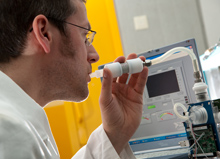Early Warning for Asthma Sufferers
Asthma is a chronic disease, much like diabetes. But while diabetics can keep track of their symptoms with glucose meters, asthma patients have little to go by beyond their own judgment. As a result, asthma causes more than a million emergency room visits each year in the U.S. alone, according to the Centers for Disease Control and Prevention.

A new handheld device could reverse that trend by helping patients catch asthma attacks hours before they happen.
The device, manufactured by Siemens, detects the early signs of airway inflammation by measuring nitric oxide in a patient’s breath. Physicians already use similar technology to diagnose asthma in the clinic, but the new device is small enough to be portable, which would make it easy for patients to monitor themselves.
Adults are more likely to miss the early signs of asthma attacks, say experts, which may explain why about 3,000 adults die from asthma each year in the U.S. “What makes these deaths particularly tragic is that, in many cases, they are completely preventable,” says Linda Rogers, a pulmonologist at the asthma clinic at Bellevue Hospital in New York City. Adults may ignore warning signs, such as coughing and chest tightness, and by the time they realize they’re in trouble and take out their rescue inhalers, it can be too late.
The Siemens sensor can alert patients of a possible asthma attack up to 24 hours in advance, giving them ample time to take preventive medications or call their doctors. The Siemens asthma sensor is not only half the size of the model that the U.S. Food and Drug Administration approved for clinical use just three years ago, it’s also five times more sensitive, detecting nitric oxide at one part per billion.
In order to be portable, though, the sensor had to be faster than existing models, too. “The ones used in the clinic are very slow,” explains Maximilian Fleischer, the physicist in charge of the Siemens project. “The breath has to be stored for a long time, which isn’t possible with a portable device that’s moving around.” Chemical modifications to the dye that traps the nitric oxide on the sensor turned out to be the key to increasing detection speed without losing accuracy.
The real test, of course, will come after the new sensor is made available to patients. Siemens hopes to market the device directly to consumers, which could bypass government regulations in some countries. Still, most physicians will want to see clinical data before recommending the sensor to patients. Nicola Hanania, director of the asthma clinical research center at Baylor College of Medicine, says he is very interested in the technology. “Personal exhaled nitric oxide monitoring is innovative and could be useful if it makes a difference in patient outcomes,” he says.
Keep Reading
Most Popular
Large language models can do jaw-dropping things. But nobody knows exactly why.
And that's a problem. Figuring it out is one of the biggest scientific puzzles of our time and a crucial step towards controlling more powerful future models.
How scientists traced a mysterious covid case back to six toilets
When wastewater surveillance turns into a hunt for a single infected individual, the ethics get tricky.
The problem with plug-in hybrids? Their drivers.
Plug-in hybrids are often sold as a transition to EVs, but new data from Europe shows we’re still underestimating the emissions they produce.
Google DeepMind’s new generative model makes Super Mario–like games from scratch
Genie learns how to control games by watching hours and hours of video. It could help train next-gen robots too.
Stay connected
Get the latest updates from
MIT Technology Review
Discover special offers, top stories, upcoming events, and more.